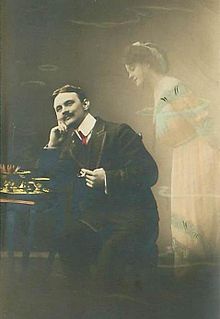- Daydream
-
This article is about the mental activity. For other uses, see Daydream (disambiguation) and Daydreaming (disambiguation).
 Daydream by Paul César Helleu
Daydream by Paul César Helleu
A daydream is a visionary fantasy, especially one of happy, pleasant thoughts, hopes or ambitions, imagined as coming to pass, and experienced while awake.[1] There are many types of daydreams, and there is no consistent definition amongst psychologists.[1] The general public also uses the term for a broad variety of experiences. Research by Harvard psychologist Deirdre Barrett has found that people who experience vivid dream-like mental images reserve the word for these, whereas many other people refer to milder imagery, realistic future planning, review of past memories or just "spacing out"--i.e. one's mind going relatively blank—when they talk about "daydreaming."[2]
While daydreaming has long been derided as a lazy, non-productive pastime, it is now commonly acknowledged that daydreaming can be constructive in some contexts.[3] There are numerous examples of people in creative or artistic careers, such as composers, novelists and filmmakers, developing new ideas through daydreaming. Similarly, research scientists, mathematicians and physicists have developed new ideas by daydreaming about their subject areas.
Contents
History
Daydreaming was long held in disrepute in society and was associated with laziness. In the late 19th century, Toni Nelson argued that some daydreams with grandiose fantasies are self-gratifying attempts at "wish fulfillment". In the 1950s, some educational psychologists warned parents not to let their children daydream, for fear that the children may be sucked into "neurosis and even psychosis".[1]
In the late 1960s, psychologist Jerome L. Singer of Yale University and psychologist John S. Antrobus of the City College of New York created a daydream questionnaire. The questionnaire, called the Imaginal Processes Inventory (IPI), has been used to investigate daydreams. Psychologists Leonard Giambra and George Huba used the IPI and found that daydreamers' imaginary images vary in three ways: how vivid or enjoyable the daydreams are, how many guilt- or fear-filled daydreams they have, and how "deeply" into the daydream people go.[1]
Recent research
Eric Klinger's research in the 1980s showed that most daydreams are about ordinary, everyday events and help to remind us of mundane tasks. Klinger's research also showed that over 75% of workers in "boring jobs", such as lifeguards and truck drivers, use vivid daydreams to "ease the boredom" of their routine tasks. Klinger found that less than 5% of the workers' daydreams involved explicitly sexual thoughts and that violent daydreams were also uncommon.[1]
Israeli high school students who scored high on the Daydreaming Scale of the IPI had more empathy than students who scored low. Some psychologists, such as Los Angeles' Joseph E. Shorr, use the mental imagery created during their clients' daydreaming to help gain insight into their mental state and make diagnoses.[4][5]
Other recent research has also shown that daydreaming, much like nighttime dreaming, is a time when the brain consolidates learning. Daydreaming may also help people to sort through problems and achieve success. Research with fMRI shows that brain areas associated with complex problem-solving become activated during daydreaming episodes.[6][7]
Therapist Dan Jones looked at patterns in how people achieved success from entrepreneurs like Richard Branson and Peter Jones to geniuses like Albert Einstein and Leonardo da Vinci. Jones also looked at the thinking styles of successful creative people like Beethoven and Walt Disney. What he found was that they all had one thing in common. They all spent time daydreaming about their area of success.[8]
Sports psychologists have used this knowledge for years without making the connection to daydreaming. They would have sports people visualise success. Studies have shown that those that use visualisation outperform those that use practice alone.[dubious ]
Nowadays it is understood that visualisation or guided imagery is the same state of mind as daydreaming.[dubious ]
See also
- Fantasy prone personality
- Fantasy (psychology)
- Maladaptive daydreaming
- Mind-wandering
- Stream of consciousness (psychology)
References
- ^ a b c d e Klinger, Eric (October 1987). Psychology Today.
- ^ Barrett, D. L. The Hypnotic Dream: Its Content in Comparison to Nocturnal Dreams and Waking Fantasy. Journal of Abnormal Psychology, 1979, Vol. 88, p. 584 591; Barrett, D. L. Fantasizers and Dissociaters: Two types of High Hypnotizables, Two Imagery Styles. in R. Kusendorf, N. Spanos, & B. Wallace (Eds.) Hypnosis and Imagination, NY: Baywood, 1996; & Barrett, D. L. Dissociaters, Fantasizers, and their Relation to Hypnotizability in Barrett, D. L. (Ed.) Hypnosis and Hypnotherapy, (2 vol.): Vol. 1: History, theory and general research, Vol. 2: Psychotherapy research and applications, NY, NY: Praeger/Greenwood, 2010.
- ^ Tierney, John (June 28, 2010). "Discovering the Virtues of a Wandering Mind". The New York Times. http://www.nytimes.com/2010/06/29/science/29tier.html?src=me&ref=general.
- ^ D. Vaitl, J. Gruzelier, D. Lehmann et al., "Psychobiology of Altered States of Consciousness," Psychological Bulletin, vol. 131, no. 1, 2005, pp. 98–127.
- ^ Warren, Jeff (2007). "The Daydream". The Head Trip: Adventures on the Wheel of Consciousness. Toronto: Random House Canada. ISBN 978-0679314080.
- ^ "Brain's Problem-solving Function At Work When We Daydream". ScienceDaily. 2009-05-12. http://www.sciencedaily.com/releases/2009/05/090511180702.htm. Retrieved 2009-05-19.
- ^ Christoff, Kalina; Alan M. Gordon, Jonathan Smallwood, Rachelle Smith, and Jonathan W. Schooler (2009-05-11). "Experience sampling during fMRI reveals default network and executive system contributions to mind wandering". Proceedings of the National Academy of Sciences 106 (21): 8719–24. doi:10.1073/pnas.0900234106. PMC 2689035. PMID 19433790. http://www.pnas.org/content/early/2009/05/11/0900234106.
- ^ 'Daydreaming for Success' article from PersonalFreedom.co.uk
External links
Categories:- Psychological adjustment
- Imagination
- Abstraction
Wikimedia Foundation. 2010.

